QUALITY SEED PRODUCTION IN SMALL ONION
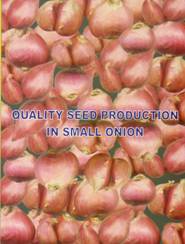
Selection of land for quality seed production
The selection of land is the first and foremost task for a seed producer. The seed production plot must be selected carefully. A fertile and healthy seed plot will certainly produce quality seed. The field selected for seed production must not have been sown with onion in the previous season. This is done to avoid volunteer plants that cause admixture. Fields continuously cultivated with onion may harbour root rot or wilt pathogen. Hence, such fields must be avoided wherever possible. Following crop rotation will help to reduce endemic pathogen.
Soil with neutral pH must be selected. Loam or clay loam soils are best suited. Higher organic matter will lead to production of vigorous seed.
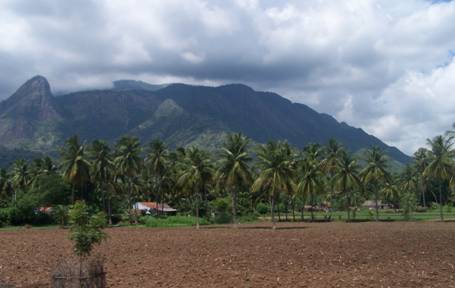
What are volunteers?
Volunteers are plants that grow in the field from the seeds found in the soil. These seeds should have been fallen from previous season crop. As they germinate without sowing or they volunteer to grow by themselves, hence the name volunteer plants.
Isolating the seed crop to avoid genetic contamination
It is more important to maintain genetic identity because of variation in onion bulb colours and also it is cross pollinated crop, mainly by honey bees and other beneficial insects. Onion seed crop should be provided a minimum isolation distance of 500 metre from other varieties, so that we can avoid genetic contamination.
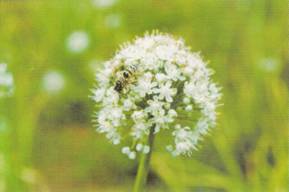
Flowering umbel pollinated by honey bees
Selecting the right season for raising seed crop
Quality of seed depends on season in which it is grown. Onion seed production is entirely differ from onion bulb or vegetable production. For onion seed production requires two different seasons. In one season quality bulbs are produced and the bulbs are again planted in second season for true seed production. The first season should be suitable for healthy and quality bulb production. The second season should be suitable for the better growth of bulb so that it facilitate good flowering and seed setting. Considering these two factors, June-September is the best season for bulb production and October-March .is for true seed production. The above seasons must be followed strictly otherwise there won't be any seed set.
Low temperature prevailing during the early second season facilitates easy flowering of bolting. Similarly dry weather, medium RH and temperatures are important for seed setting and maturity. The above factors facilitate for harvesting higher yield of quality seeds in onion.
Producing quality seedlings for transplanting
Selection of quality seeds will pave way for production of vigourous seedling and it is more important. Transplanting healthy and vigourous seedlings in the main field will be useful for the seedling to grow faster by utilizing the applied nutrients, develops resistance to pest and diseases and avoid gap filling operations. Hence, proper nursery management is more important to produce healthy vigourous seedlings.
Seed selection
The quality seed should be used for getting healthy seedlings. The crop yield to tally depends on the seed quality. In seed crop, we should aim for higher yield without sacrificing genetic purity and it is more important. The yield and quality depend on the seed selection. Hence, for raising seed crop we should choose breeder seed or foundation seeds.
Nursery preparation and sowing
After selection of quality seeds, it is more important to produce healthy seedlings. For raising vigourous seedlings we have to form raised nursery beds in an area of three cents applied with 200 kg of decomposed farm yard manure.
Sowing
For transplanting one acre, 2.5 - 3 kg of seeds can be sown in the raised nursery beds formed in an area of 3 cents. On the nursery beds, seeds should be sown in lines formed at a distance of 10 cm. After sowing, the seeds should be covered with sand or loose soil. Then the beds must be irrigated by immersing of the whole beds with water. After germination, nursery would be irrigated once in a week.
It is more important that nursery beds should be formed with one meter breadth. This facilitates easy weeding and proper application of fertilizers or nutrients.
Fertilizer application
As the nutritious food for children is important similarly nursery also needs nutrient application. Application of 2 kg DAP (or) 6 kg urea plus 12kg super phosphate per cent nursery will be useful for the growth of the seedlings. Also it will be helpful for pulling out of seedlings without any damage to root system. Transplanting these healthy seedlings is highly useful for easy crop establishment in main field.
Age of the seedling
The age of the seedling is more important for crop establishment and it also influences the crop yield. Hence, for onion 35-40 days old seedlings are found to be optimum age for transplanting.
Production of quality onion
During the first season in onion seed production we have to produce the quality bulbs. It is more important because the seed yield and quality depend on the bulbs that are produced.
Main field preparation and management
Land selected for raising seed crop should be ploughed thoroughly for two (or) three times. At the last plough, 20 tonnes of FYM per acre has to be incorporated into the soil. Then ridges and furrows are to be formed at a spacing of 20 Cm.
After forming the ridges and furrows, the recommended doses of N, P and K fertilizers has to be applied on the 1/3 rd height of ridges as a basal dose. Application of basal doses of fertilizers will be more important and support for the early vigourous growth of the seedlings. The basal fertilizer requirement per acre for onion seed crop is as follows.
Urea: 26 kg, Super: 144 kg and Potash: 19 kgs
Transplanting
The healthy seedlings pull out from well maintained nursery has to be used for transplanting. After the irrigation i.e. complete soaking of ridges, single seedling should be transplanted at the spacing of 10 Cm.
Weeding
From the beginning, onion field should be maintained in such way that it must be free from weed. Because, weed growth will affect the quality bulb harvest. Hence, two manual weeding may be taken up at 20-25 days after planting and 40-45 days after planting. This will facilitate quality bulb production.
Top dressing
Top dressing with fertilizer is more important for onion bulb production, other wise it will not be useful for further transplanting for onion true seed production. Hence, 26 kg of urea may be applied as top dress on 30th day after planting. This will be useful for vegetative growth and bulb growth.
Plant protection
Maintaining plant health is more important and hence propolytic plant protection measure should be taken.
Aphids: Tip drying of leaves and to control this pest spray methyl dematan @ 500ml/ha (or) phosphomedon @ 300ml/ha. Avoid excess application of urea and close planting.
Leaf spot: Spray mancozeb @ 2g/lit of water.
Roguing for quality bulb production
In the main field sometime abnormal difference in growth habits in some plants may be noticed and this shows the admixture of some other varieties. This may very much affect the genetic purity of that particular onion seed crop and ultimately the crop will not be fit for a seed crop. Hence, in the onion seed crop field removal of off type plants, weeds and disease infested plants is to be done scrupulously before it comes to harvest to avoid the physical contamination.
The roguing operations are to be taken at different stages namely vegetative stage and after harvest.
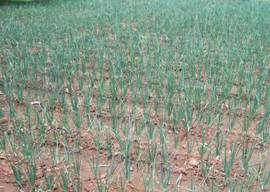
Onion bulb production field
Bulb harvest
Bulb harvest may be done at 110-115 days after planting (or) a week after the visual symptom of fallen of leaves in 50% population at that stage bulbs attained full maturity. The bulbs should be lifted from the soil along with leaves. The lifted bulbs along with leaves should be allowed in the field (or) in the shade for curing for 3-5 days. Then the leaves are to be cut at an height of 2.5 cm from the neck of the bulb.
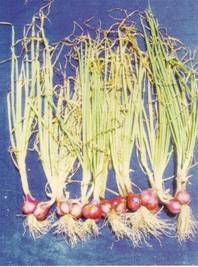
Harvest ready onion
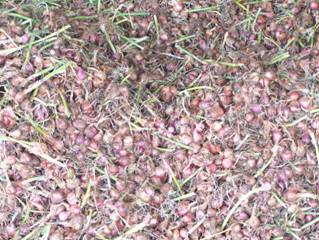
Harvested onion bulb
True seed production
Only during second season we are doing true seed production. The bulbs produced during June-September are being used for planting. The seed yield and quality depend on the technologies we are following during second season.
Bulb selection and grading
Based on the colour, shape and size of the bulb and confirming to varietal characters should be selected for sowing. Then the selected bulbs have to be cured for at least 15 days. The bulbs selected confirming varietal character should possess at least 4-6 cm diameter. The smaller bulbs may be used for vegetable purpose.
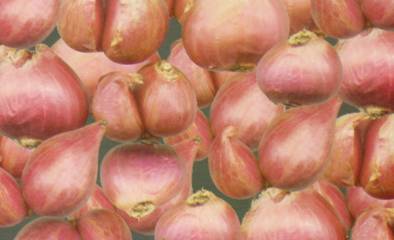
Bulb selection
The cool weather prevailing after bulb planting will be useful for good flowering. Good sun shine at the time of full blooming stage will facilitate the activity of beneficial insects for higher rate of cross pollination and seed set. The relative humidity should be lower at the time of seed development. All these factors will be there during October-November.
Bulb treatment
The top portion (3-5 mm) of the bulb has to be cut and removed. Then the bulbs are to be treated with bavistin (or) dithane M45 @ 20 g/l0 litre of water for 5-10 minutes before sowing. This will protect the bulb from soil borne pathogen until its germination.
Main field preparation and management
Land selected for raising seed crop should be ploughed thoroughly for two (or) three times. At the last plough, 20 tonnes of FYM per acre has to be incorporated into the soil. Then ridges and furrows are to be formed at a spacing of 30 cm.
After forming the ridges and furrows, the recommended doses of N, P and K fertilizers has to be applied on the 1/3rd height of ridges as a basal dose. Application of basal doses of fertilizers will be more important and support for the early vigourous growth of the seedlings. The basal fertilizer requirement per acre for onion seed crop is as follows.
Urea: 26 kg, Super: 144 kg and Potash: 19 kgs
Planting
Treated bulbs alone must be used for planting. After complete soaking of ridges, the bulbs are to be planted at 10 cm spacing. The women are playing major role in bulb planting. The field should be again irrigated three days after planting. This facilitate for easy germination of bulbs.
Weed management
From the beginning, the field should be maintained from free of weeds, otherwise the weed competition will reduce the quality of seed. Hence, two manual weeding may be taken up at 20-25 days planting and 40-45 days after planting. This will facilitate for flowering production.
Top dressing
Top dressing with fertilizer is more important for seed production. Hence, 26 kg of urea may be applied as top dress on 30th after day planting. This will be useful for good flowering and seed set.
Roguing for quality seed production
Already we have seen the importance of isolation distance for quality seed crop. Now, we are going to learn how the off types and rogues influence the quality of seed and by roguing operation how the genetic purity of the variety is being maintained
In the main field sometime we are noticing abnormal difference in growth habits in some of the plants and this shows the admixture of some other varieties. This may very much affect the genetic purity of that particulars onion seed crop and ultimately the crop will not be fit for a seed crop. Hence, in the onion seed field, removal of off type plants, weeds and disease infested plants is to be done scrupulously before it comes to harvest to avoid the genetic contamination.
In roguing operations are to be taken at different stages namely vegetative stage, flowering and after harvest.
Harvest
Harvest must be done only after complete maturation of seed. The best time of harvest is the 50% of the seeds in the umbel is exposed. At the stage umbels alone should be harvested in 3 to 4 pickings at an interval of 45 days. The harvested umbels have to be dried under shade.
Harvest must be done at the time of 50 % of seeds in the umbel is exposed, otherwise there will be shattering loss in seed yield.
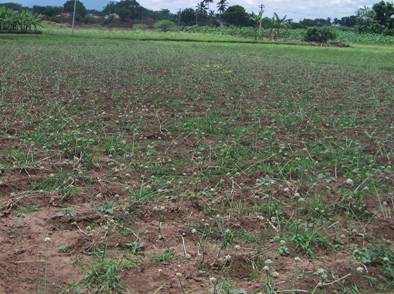
Seed production field
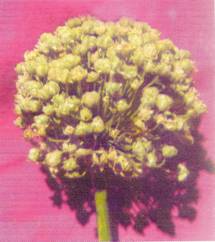
Harvestable maturity
Methods to improve seed quality
The seeds must be properly separated from the umbels. While seed extraction there should not any damage to seed. Then the seeds must be dried properly.
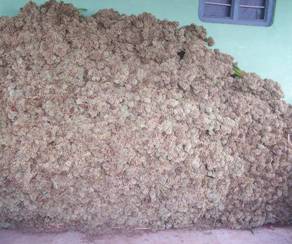
Shade drying of seed umbels
Seed extraction
The properly dried umbels are to be taken in a cloth bag and the seeds may be separated by hand rubbing (or) beating against with pliable bamboo sticks. The extracted seed should be cleaned by manual winnowing.
Seed drying
The extracted seed must be dried properly under shade for 8 to 10 hours after spreading over the gunny bags. Then, it can be dried further under open sun light between 8 to 12 noon and 3 to 5 PM. Avoid drying in between 12 to 3 PM, since the rays emits from sun and the heat may affect
the seed viability.
After extraction seeds should not be dried under direct sun light between 12-3 pm. And also seeds should not be dried continuously from the morning to evening. These two factors will affect the germination.
Seed processing
After proper drying, the seed processing is essential. This will be helpful for maintaining high vigour and viability by way of removing immature and small seeds. In the processing we have to remove broken, immature and diseased seeds, other crop and weed seeds, mud and other inert matters. For processing onion seeds, BSS 10 x 10 wire mesh sieve should be used.
Storage of unprocessed seeds results in poor viability. In processing, the sieves must be cleaned while changing to other variety otherwise it leads to physical admixture results in genetic contamination. Hence, utmost care must be taken during processing of seeds to maintain quality.
Protecting seeds during storage
Importance must be given for proper storage of seeds until next season as that of the importance given for production.
Moisture content
Seed quality mainly depends on the seed moisture. If seed moisture content is high normally it loses its viability at faster rate. For short term storage seed moisture content should be reduced to 7-8% and can be stored in cloth. For long term storage seed moisture content should be reduced to 6% and stored in moisture vapor proof containers.
Seed treatment
Seeds must be treated with fungicides before storage. The seeds may be treated with captan or Thiram @ 4 g/kg of seeds. The seeds can also be treated with halogen mixture @ 5g/kg of seed and it is a ecofriendly seed treatment.
Storage containers
Seeds could able to absorb moisture from atmosphere. Hence for storing seeds in the coastal region (or) river sides we should use moisture vapour proof containers i.e. 700 gauge polyethylene bags. For seed storage every time new containers must be used.
Seed certification
Seed certification guarantees the quality of seed as it ensures that the certified seed has the genetic, physical, physiological and seed health qualities. Genetic purity means that the seed gives rise to a plant which conforms to the varietal characteristics of the variety. The physical purity means that the seed is free from stones, broken seeds, straw bits and leaf bits etc. Physiological quality is measured by germination and seed health envisages freedom from pest and diseases.
Seed certification is being done in many stages. It starts from verifying whether seeds were obtained from authenticated source, verification of isolation distance and inspection during plant growth, flowering, harvesting, processing and bagging. Also seed samples are drawn form the seed lot and sent to seed testing lab to test whether the seeds are possessing required physical purity and germination. Then certification tag is issued. Colour of the tag is blue for certified seeds.
Only those seeds harvested from fields having prescribed field standards and possessing required seed standards are certified by the Certification Agency. Seeds thus certified are offered for sales. For further details nearer seed certification office may be contacted.
Minimum certification standards
Field standard |
|
Other variety bulbs (max.) |
0.2% |
Off types (max.) |
0.2% |
Seed standards
Pure seed (minimum) |
98.0% |
Inert matter (maximum) |
2.0% |
Other crop seeds (maximum) |
10/kg |
Weed seeds (Maximum) |
10 /kg |
Germination (minimum) |
70% |
Moisture (maximum) |
|
For vapour proof containers |
6.0% |
Moisture previous containers |
8.0 |
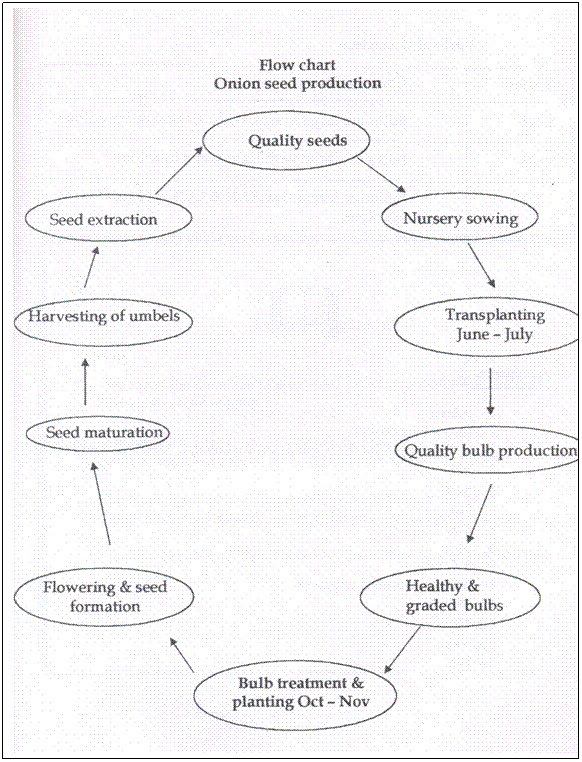
|











